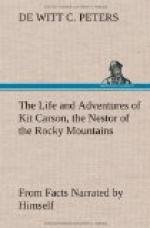tails and swim with their cargoes elevated above and
free from the water. When they arrive at an unfinished
point of the dam they dump the mud and mould it in
place. Their houses they have previously built
in the river banks. These consist of holes which
lead into large and airy subterranean rooms, and which
are above the water-mark. In these houses they
are said to sleep and live in pairs; and, if we could
believe the story of the trapper related many pages
back, they imitate human beings in managing their
household and in keeping house. The main object
they have in staying the progress of the current of
the river is to afford a deep place where, having
fallen numbers of trees, the deep water will preserve
tender and fresh the limbs and shrubs on which to
subsist during, not only time present, but also time
to come. It is well known that fresh branches
of trees and young willows, when placed in water,
will keep up partial life for a considerable length
of time. On this principle, the beaver acts in
submerging his food deep in the water where it will
retain its verdure and where the freezing process
that is going on at the surface of the river will
not bar his efforts in getting at his store of provisions
during the winter season. It is said that the
beaver goes so far as to bundle up small branches
of trees and willows which he stows away in the muddy
bottom of the river. The trapper, in his wondrous
yarns, insists that there are grades of society among
beavers the same as among men; and he will have it
that they have their “head chiefs,” and
that often individuals among them roll in wealth and
that they have slaves who stand ready to do their
master’s bidding at a moment’s warning;
for instance, to bring them a bundle of green twigs
on which to feast. According to their imaginative
stories, the life of a beaver cannot be rivaled in
happiness; and if we could put full credence in their
descriptions of the pastimes of the animal, his palaces
and luxuries, we could only compare a beaver to a
citizen of Venice in her most palmy days—the
difference between the two being, that the former
enjoyed himself more in the water than the latter did
on it in his favorite
gondola.
The beaver, when captured young, can be sufficiently
domesticated to make him a pet; but their unattractive
form is anything but an ornament to the house.
With young children, they are very friendly, though
their disposition is amiable to any one. They
are very neat in their person and, when moved from
their comrades and domiciled with human beings, nothing
do they so much like as being allowed the daily privilege
of taking a clean bath. When thus engaged, they
are a curiosity to look at, as they are very agile
and particular in removing every particle of dirt.
We remember seeing one of these pets in the Mexican
town of Culebro thus enjoying himself.
His owner hesitated not in taking the animal to the
river, which was close by, and giving him his freedom.
On finishing his ablutions the beaver returned to
where his owner was standing, without making an effort
to escape, and by a look as much as said, “I
am ready to return to your home.”




